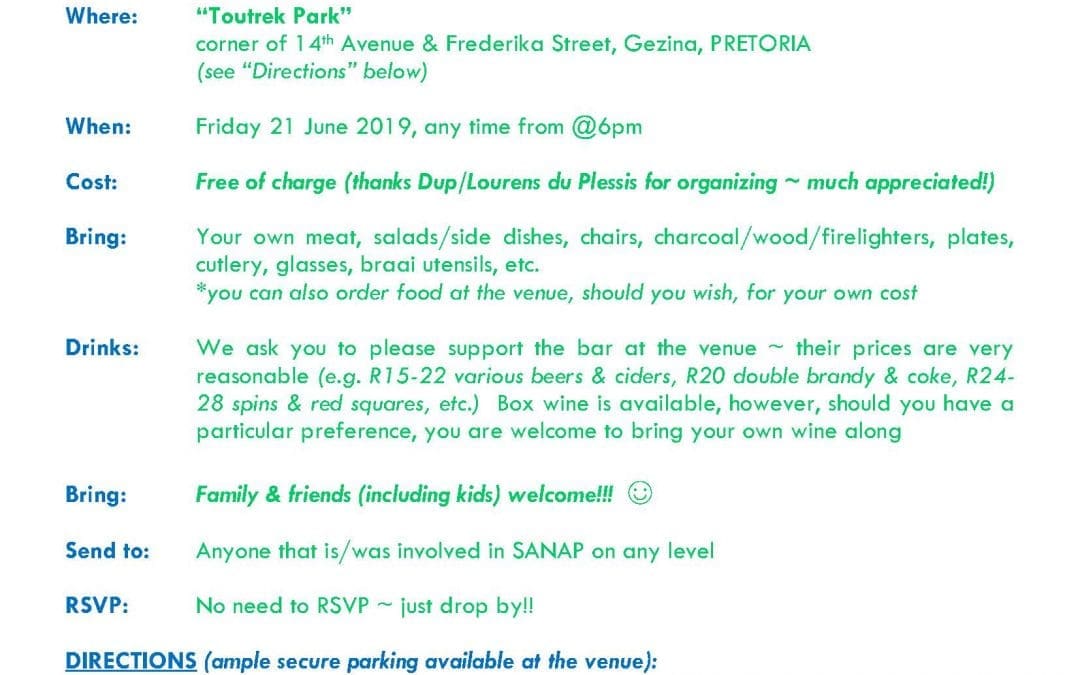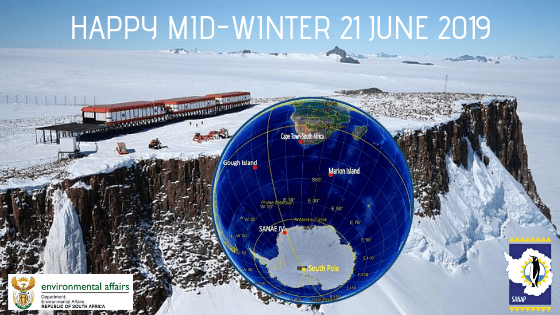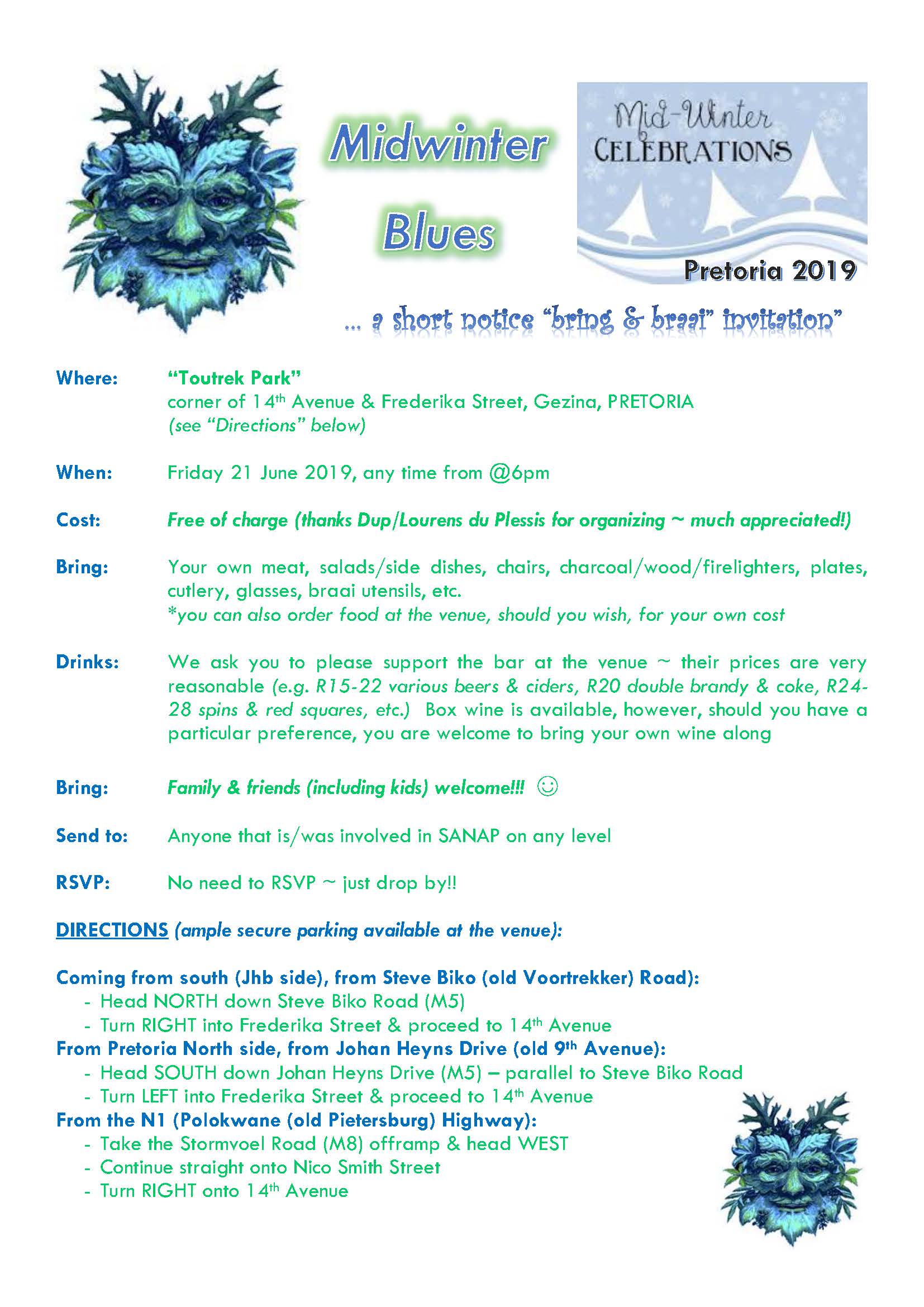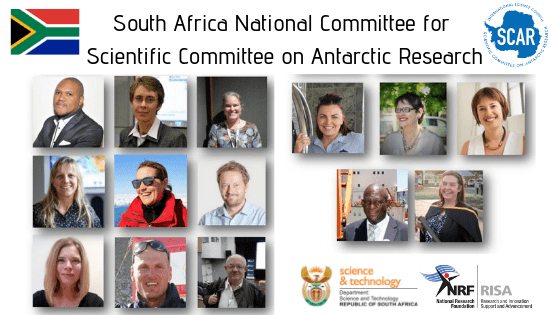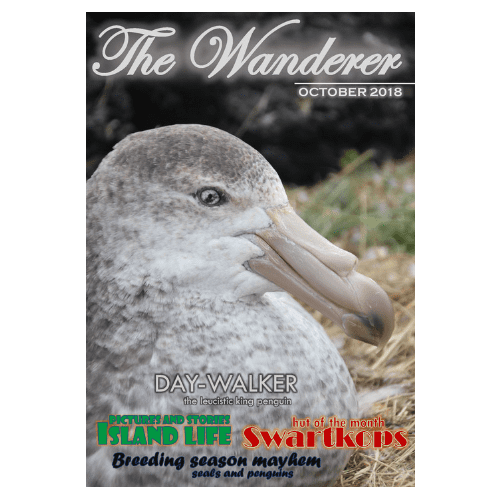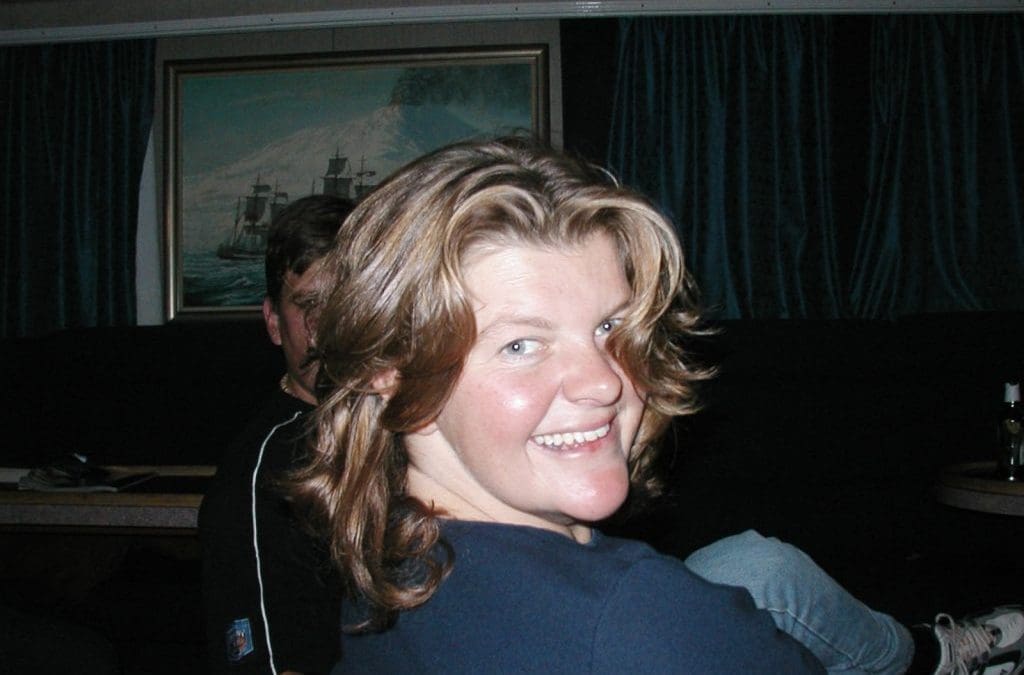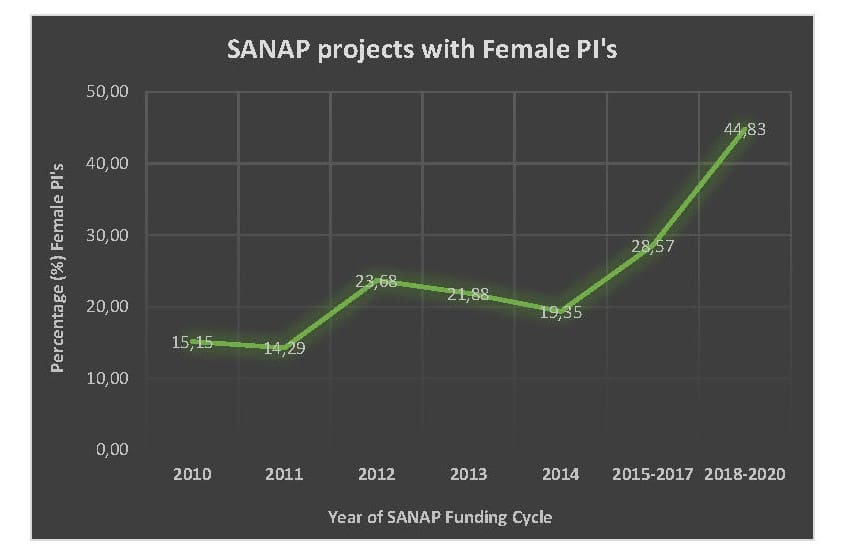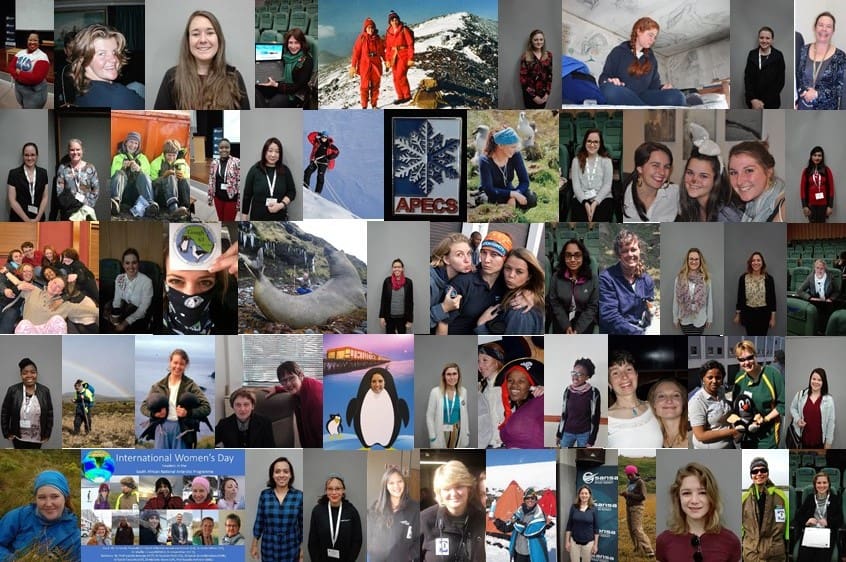
by Fishgate@sanap | Aug 13, 2019 | Antarctica, Important Dates, Marion Island, News, Overwintering Team, Research, SANAE, Science, Take-Over Operations
August is a very special month for women in South Africa and this said we would like to salute women within the South African National Antarctic Programme.
SANAP is filled with strong women in Antarctic, sub-Antarctic and Southern Ocean research. The programme also consist of a number of brave women overwintering at the South African research stations (Marion Island, Gough Island and Antarctica).
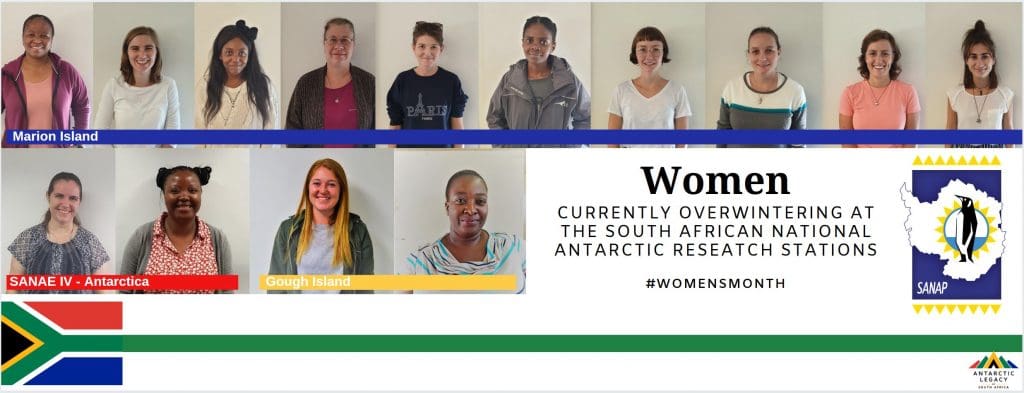
There are 29 National Research Foundation/Department of Science and Technology funded projects within SANAP and 13 of these are managed by women. This is evident that women definitely have a place within Antarctic research.
The South African National Space Agency (SANSA) sends four volunteers to Antarctica every year. These volunteers assist with hard work (physically and mentally). The last take-over to Antarctica, three of the four South African National Space Agency (SANSA) volunteers were women.
During my trip to Antarctica earlier this year, I had the opportunity to meet a number of very inspiring women – in the video below, meet the three SANSA volunteers of the 2018/2019 Antarctic take-over and the new VLF (Very Low Frequency) SANSA Engineer, who is currently overwintering at the South African National Antarctic Expedition station (SANAE IV).
Anché Louw, Antarctic Legacy of South Africa, 13 August 2019.

by Fishgate@sanap | Jun 21, 2019 | Antarctica, Current Event, Gough Island, Important Dates, Marion Island, News, Overwintering Team, SANAE, SANAP
Mid-Winter is celebrated right across Antarctica by all the nations & stations. It is the 0ldest tradition in Antarctica and refers to the Winter Solstice (or hibernal solstice). It occurs when one of the Earth’s poles has its maximum tilt away from the Sun. It happens twice yearly, once in each hemisphere (Northern and Southern). For that hemisphere, the winter solstice is the day with the shortest period of daylight and longest night of the year, when the Sun is at its lowest daily maximum elevation in the sky.

At the pole, there is continuous darkness or twilight around the winter solstice. Its opposite is the summer solstice.
The winter solstice occurs during the hemisphere’s winter. In the Southern Hemisphere, this is the June solstice (usually 20 or 21 June). Although the winter solstice itself lasts only a moment, the term sometimes refers to the day on which it occurs. Other names are “midwinter”, the “extreme of winter” (Dongzhi), or the “shortest day”.
So, for Antarctic Expeditioners / Overwinterers the worst is over with regards to dark (lack of light and sunlight).
Happy Mid- Winter to all – share this email far and wide.
From all of us
Jasmine Arnold
Office Administrator to The Ship’s Operations Manager | Directorate: Southern Oceans & Antarctic Support | Office address: East Pier, Waterfront | Direct no: 021 405 9485 | Switchboard: 021 405 9400
Mid-winter Event Pretoria, South Africa – organised by Carol Jacobs :


by Fishgate@sanap | Mar 14, 2019 | Announcement, Antarctica, Marion Island, News, Research, SANAP, Science, Southern Ocean
South Africa has been involved in Antarctic research since the geophysical year of 1957. The first 10 years of South Africa’s science and research in the Antarctic is highlighted in an article by DG Kingwell, at that stage the secretary of the South African Scientific Committee for Antarctic Research (SASCAR).
The Antarctic Research of South Africa is part of The International Science Council (ISC), South Africa.
South Africa is a national member of ISC through the National Research Foundation (NRF) and the Human Sciences Research Council (HSRC) supported by the Department of Science and Technology (DST). The South African ISC -Secretariat serves the scientific community and the ISC scientific unions and affiliates to which South Africa adheres. The SA ISC Secretariat provides support and organisational services for the ISC National Board of SA, and to the SA ISC National Committees to advance South Africa’s position in international platforms. The total membership of these committees is in excess of 200 scientists. Approximately 100 South Africans serve on ICS-related commissions and working groups. The ISC activities in South Africa are focused on the following principals:
- Science-for-policy: Stimulate and support national and international scientific research and scholarship, and to communicate science that is relevant to national and international policy issues;
- Policy-for-science: Promote developments that enable science to contribute more effectively to major issues in the national and international public domain;
- Science-for-society: Stimulate science engagement with society;
- Scientific freedom and responsibility: Support the free and responsible practice of science;
- Adherence: Support committees through payment of ISC membership dues.
South Africa Science and Research is also part of the Scientific Committee on Antarctic Research (SCAR) where the committee members will represent South Africa at SCAR meetings.
The new National Committee has been announced in a letter by Tracy Klarenbeek – Professional Officer, Knowledge Advancement and Support (KAS) and their first meeting took place at Stellenbosch University on 6 March 2019.
Dear SANAP Community,
It gives me great pleasure in sharing the names of the individuals selected to represent us all at SCAR. Of course, these individuals will rely heavily on inputs from the entire community, so I sincerely hope that you will be available to support them in their endeavours. Members of the community that are not an the steering committee are still strongly encouraged to participate in SCAR and SCAR-related activities. The DST and the NRF are planning a follow-up meeting with the whole community, hopefully by the middle of the year (academic and other schedules permitting), so as to give feedback on a number of initiatives ongoing that will possibly impact on us all, including plans for current and future SA participation in SCAR. We look forward to seeing you there.
The final list is below, the details of which will be communicated to SCAR in due course. Professor Bettine van Vuuren was nominated as the Committee Chair, Tracy Klarenbeek as Vice-Chair and Dr Gilbert Siko representing the Department of Science and technology.
Life Sciences Standing Committee of SCAR
- Thulani Makhalanyane (South African Representative)
- Bettine van Vuuren
- Anne Treasure

Physical Sciences Standing Committee of SCAR
- Sandy Thomalla
- Sarah Fawcett (South African Representative)
- Stefan Lotz

Geosciences Standing Committee of SCAR
- Christel Hansen
- Werner Nel
- Geoff Grantham (South African Representative)

Social Sciences and Humanities Standing Committee of SCAR
- Anché Louw
- Ria Olivier (South African Representative)
- Charne Lavery

Please give this committee your support in their efforts to take South African science to the world via SCAR.

by Fishgate@sanap | Nov 19, 2018 | Legacy, Marion Island, Marion75, News
Greetings to all from our little island down south
We have had a great month here on Marion! October has been very productive for the field assistants and the huts have been experiencing a steady stream of visitors and some have been housing long term residents where there is lots to do nearby. Back at base all is running smoothly and we are all kept warm and well fed!

We hope you enjoy this edition of the Wanderer (October 2018) and that it gives you all a taste of our fantastic experience here!
Please click here to view all M75’s newsletters written so far.
Author: James Burns, 75th Marion Island Overwintering Team (Meteorological Observer), 19 November 2018

by Fishgate@sanap | Sep 26, 2018 | Announcement, Antarctica, Gough Island, Marion Island, News, SANAE

In memory of Ms Edna Molewa, who passed away on 22 September 2018, South Africa’s National flag at the SANAP research stations on Marion Island, Gough Island and Antarctica will be flown at halfmast.
Please click here for memorial and funeral service dates.

by Fishgate@sanap | Aug 28, 2018 | Antarctica, Gough Island, Important Dates, Legacy, Marion Island, News, Southern Ocean
May you be inspired by the women within South Africa’s Antarctic Programme.

All the women that attended the 5th South African National Antarctic Programme (SANAP) Symposium, earlier this month in Hermanus.
Women sitting here have been dreaming about a career in science and science related positions within the South African National Antarctic Programme. These are all ordinary women, but due to ambition and extremely hard work they are, or are becoming the best in their fields of research.
There is an increasing trend with regards to female Principal Investigators (PI’s) within South Africa’s Antarctic Programme (See Figure below). Of the 29 DST-NRF funded research projects within SANAP (for the period of 2018 to 2020), the Principal Investigator for 13 of these are women.
Women are represented in all four research themes within SANAP (Themes: Earth Systems, Living Systems, Human Enterprise and Innovation: Southern Ocean and Antarctic technology and engineering). Read more about these themes in South Africa’s Antarctic and Southern Ocean Research Plan for 2014 to 2024 (Click here).
Who is the Principal Investigator (PI)
“A Principal Investigator is the primary individual responsible for the preparation, conduct, and administration of a research grant in compliance with applicable laws and regulations and institutional policy governing the conduct of sponsored research.” (www.umass.edu)

Women are represented in all four research themes within SANAP (Themes: Earth Systems, Living Systems, Human Enterprise and Innovation: Southern Ocean and Antarctic technology and engineering). Read more about these themes in South Africa’s Antarctic and Southern Ocean Research Plan for 2014 to 2024 (Click here).
To all the women who:
- are or have been principal investigators of research projects within SANAP;
- obtained an Honours, Master’s, PhD or Post-Doc through South Africa’s Antarctic programme (SANAP);
- still study to become a scientist through SANAP;
- worked on research vessels, studying towards a scientific degree;
- overwintered on Marion Island, Gough Island or SANAE (Antarctica);
- spent a take-over on Marion Island, Gough Island or SANAE (Antarctica);
- started their careers within South Africa’s Antarctic programme;
- work behind the scenes of the Antarctic Programme (DST, NRF and DEA);
- feel SANAP meant the world to them by being the stepping stone for their futures,
…may you keep inspiring women to become what they want to be!

Only a few of the ladies who are or were involved in SANAP.
Inspiring female SANAP Scientist: Prof Isabelle Ansorge (UCT, Department of Oceanography) – Read her inspiring story here!

Prof Isabelle Ansorge, as a young researchers, on the Marion cruise onboard the S.A. Agulhas I in 2003.
Author: Anché Louw (Antarctic Legacy of South Africa), 28 August 2018



